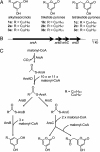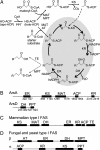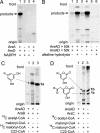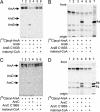Direct transfer of starter substrates from type I fatty acid synthase to type III polyketide synthases in phenolic lipid synthesis
- PMID: 18199837
- PMCID: PMC2242712
- DOI: 10.1073/pnas.0709819105
Direct transfer of starter substrates from type I fatty acid synthase to type III polyketide synthases in phenolic lipid synthesis
Abstract
Alkylresorcinols and alkylpyrones, which have a polar aromatic ring and a hydrophobic alkyl chain, are phenolic lipids found in plants, fungi, and bacteria. In the Gram-negative bacterium Azotobacter vinelandii, phenolic lipids in the membrane of dormant cysts are essential for encystment. The aromatic moieties of the phenolic lipids in A. vinelandii are synthesized by two type III polyketide synthases (PKSs), ArsB and ArsC, which are encoded by the ars operon. However, details of the synthesis of hydrophobic acyl chains, which might serve as starter substrates for the type III polyketide synthases (PKSs), were unknown. Here, we show that two type I fatty acid synthases (FASs), ArsA and ArsD, which are members of the ars operon, are responsible for the biosynthesis of C(22)-C(26) fatty acids from malonyl-CoA. In vivo and in vitro reconstitution of phenolic lipid synthesis systems with the Ars enzymes suggested that the C(22)-C(26) fatty acids produced by ArsA and ArsD remained attached to the ACP domain of ArsA and were transferred hand-to-hand to the active-site cysteine residues of ArsB and ArsC. The type III PKSs then used the fatty acids as starter substrates and carried out two or three extensions with malonyl-CoA to yield the phenolic lipids. The phenolic lipids in A. vinelandii were thus found to be synthesized solely from malonyl-CoA by the four members of the ars operon. This is the first demonstration that a type I FAS interacts directly with a type III PKS through substrate transfer.
Conflict of interest statement
The authors declare no conflict of interest.
Figures





Similar articles
-
Phenolic lipid synthesis by type III polyketide synthases is essential for cyst formation in Azotobacter vinelandii.Proc Natl Acad Sci U S A. 2006 Apr 18;103(16):6356-61. doi: 10.1073/pnas.0511227103. Epub 2006 Apr 5. Proc Natl Acad Sci U S A. 2006. PMID: 16597676 Free PMC article.
-
Phenolic lipids synthesized by type III polyketide synthase confer penicillin resistance on Streptomyces griseus.J Biol Chem. 2008 May 16;283(20):13983-91. doi: 10.1074/jbc.M710461200. Epub 2008 Mar 24. J Biol Chem. 2008. PMID: 18364359
-
Enzymatic synthesis of bis-5-alkylresorcinols by resorcinol-producing type III polyketide synthases.J Antibiot (Tokyo). 2009 Jul;62(7):371-6. doi: 10.1038/ja.2009.44. Epub 2009 Jun 26. J Antibiot (Tokyo). 2009. PMID: 19557027
-
The architectures of iterative type I PKS and FAS.Nat Prod Rep. 2018 Oct 17;35(10):1046-1069. doi: 10.1039/c8np00039e. Nat Prod Rep. 2018. PMID: 30137093 Free PMC article. Review.
-
Type III polyketide synthases in natural product biosynthesis.IUBMB Life. 2012 Apr;64(4):285-95. doi: 10.1002/iub.1005. Epub 2012 Feb 23. IUBMB Life. 2012. PMID: 22362498 Review.
Cited by
-
Using Chemical Knowledge to Uncover New Biological Function: Discovery of the Cylindrocyclophane Biosynthetic Pathway.Synlett. 2013 Jul;24(12):1464-1470. doi: 10.1055/s-0033-1338879. Synlett. 2013. PMID: 31723311 Free PMC article.
-
Cylindrocyclophane biosynthesis involves functionalization of an unactivated carbon center.J Am Chem Soc. 2012 Nov 14;134(45):18518-21. doi: 10.1021/ja308318p. Epub 2012 Nov 2. J Am Chem Soc. 2012. PMID: 23106426 Free PMC article.
-
Transcriptome analysis of Azospirillum brasilense vegetative and cyst states reveals large-scale alterations in metabolic and replicative gene expression.Microb Genom. 2018 Aug;4(8):e000200. doi: 10.1099/mgen.0.000200. Epub 2018 Jul 30. Microb Genom. 2018. PMID: 30058999 Free PMC article.
-
Characterization of an Orphan Type III Polyketide Synthase Conserved in Uncultivated "Entotheonella" Sponge Symbionts.Chembiochem. 2020 Feb 17;21(4):564-571. doi: 10.1002/cbic.201900352. Epub 2019 Oct 22. Chembiochem. 2020. PMID: 31430416 Free PMC article.
-
A polyketide macrolactone synthase from the filamentous fungus Gibberella zeae.Proc Natl Acad Sci U S A. 2008 Apr 29;105(17):6249-54. doi: 10.1073/pnas.0800657105. Epub 2008 Apr 21. Proc Natl Acad Sci U S A. 2008. PMID: 18427109 Free PMC article.
References
Publication types
MeSH terms
Substances
LinkOut - more resources
Full Text Sources
Molecular Biology Databases
Research Materials
Miscellaneous

